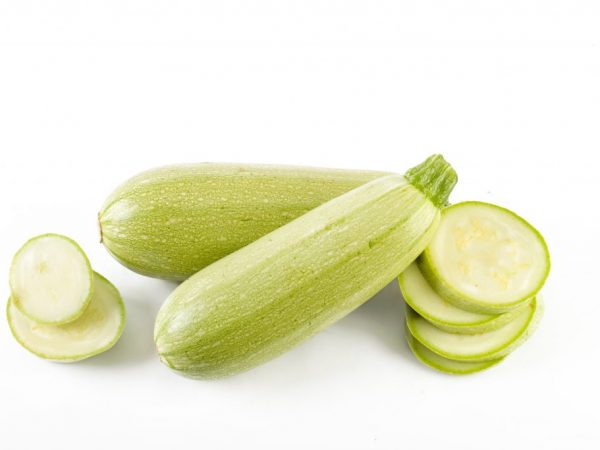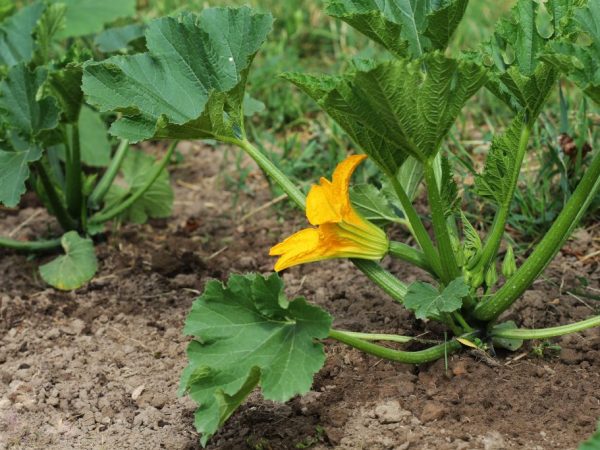Growing zucchini Aral F1
Zucchini Aral F1 is one of the few early maturing varieties that is unpretentious in care and planting. The vegetable has a number of positive properties that make it popular among gardeners.

Growing zucchini Aral F1
Characteristics of the variety
Zucchini grow on medium-sized bushes, from one you can collect 4-5 fruits. The plant hardly weaves, has medium internodes, and, which is convenient for harvesting, it is half-open.
Description of fruits
The fruits are similar to each other - they have approximately the same length and weight. The shape of the vegetable is cylindrical. The weight of one fruit is 500-800 g, the length is 16-18 cm, and the diameter is at least 6 cm.
The rind is of medium thickness and has a pleasant light green color. There are many small white blotches on it. The Aral zucchini variety has a tender, tasty and dense pulp. Inside the vegetable there are large seeds that are easy to get rid of.
If the fruits are picked on time, they can be stored for more than 4 months. The peel and pulp contain many vitamins and minerals. Zucchini is 95% water. They contain 0.6% protein, 2.55% sugar and 0.13% fat.
The pulp contains B vitamins, as well as vitamins C, E, K and PP. It is beneficial for hair growth. Of the microelements in the culture - magnesium, calcium, phosphorus, sodium, silicon, copper and iron. Their total content is 5%.
Yield
The characteristic of the variety suggests that the Aral F1 is a high-yielding species. Ovaries form quickly on the bush. Even if the first crop has been harvested, after a while it will be possible to shoot the next one.
With proper planting and proper care, the yield of the variety per 1 sq. m can be up to 10 kg, and 500 kg of fruits can be harvested from 1 hectare. If we compare this species with others, we can conclude that it is the most productive of all early ripening varieties of zucchini.
Scope of the fruit
Zucchini Aral f1 have a wide range of applications. Vegetables promote good digestion, restore water-salt metabolism, thanks to fiber they can absorb toxins, salt, bad cholesterol. They are eaten for diseases of the gastrointestinal tract, diseases and disorders of the heart, blood vessels, kidneys, gall bladder.
The description of the pulp of these fruits suggests that it has a moisturizing effect and heals wounds well, thanks to which zucchini is used even in medicine and cosmetology.
Vegetables have a mild diuretic effect, so they are recommended for edema.
Disease and pest resistance

The plant is immune to disease
A huge advantage of the Aral F1 variety is that the bushes and fruits are resistant to both diseases and pests. The plant has immunity to root rot and mold, the virus of watermelon mosaic and yellow mosaic of zucchini, and this is a guarantee of long-term productivity and long storage of vegetables.
The plant is resistant to pests, but it can still succumb to insect attacks. To avoid this, select thorough care for the culture in advance.
Advantages and disadvantages of the variety
If a plant has a short growing season, it is unpretentious in planting and care, and its fruits have a good taste and are stored for a long time. Gardeners will definitely pay attention to him.
The advantages of the variety are:
- zucchini of the Aral variety ripen early. Just a month after planting, ripe fruits appear on the bushes that can be harvested;
- the plant is highly resistant to various viral and bacterial diseases, which is why it has regular fruiting;
- many fruits are tied on one bush, therefore the variety is characterized by high productivity;
- bushes bear fruit well in different terrain and under different weather conditions;
- the harvest after harvest can be stored for more than 4 months.
There are also several disadvantages to the variety. The fruits are susceptible to attacks by various insects, so they need to be processed periodically. They have large seeds that have to be removed before cooking. If the fruits are harvested a little ahead of time, they will quickly deteriorate.
Growing
When a person has decided on the choice of the culture and variety that he wants to plant, you need to figure out how to do it correctly so that the plant develops well.
Landing
Find the right place for culture. The south side is suitable for her, so that enough light and heat gets on the plant. For planting, the ground must warm up well. It is advisable to carry out work in late spring or early summer.
You can plant the Aral zucchini in two ways.
The first involves planting seeds directly into heated soil. In this case, there is no guarantee of the appearance of early fruits, but with the seeds there is less hassle. Pre-prepared and treated seeds are sown in soil with a temperature of 12-14 ° C in late May - early June. Seedlings will be visible in a few days, and the harvest itself can be harvested in July.
Before planting, the seeds are treated in a concentrated solution of potassium permanganate. The soil does not require special preparation, except for abundant watering. The seeds are lowered shallowly, 3-4 cm.
The second way is seedlings. Here you need to calculate the timing, tk. seedlings will sprout for a month. The seeds are laid out on a damp cloth, where they are left for 3 days. The fabric should be wetted periodically. Then the contents must be put in the refrigerator for a couple of hours, because this is how the plant gains immunity to frost.

Seeds must be hardened before planting.
After these procedures, the seeds are transplanted into small pots or other containers. Peat pots are ideal.
Seedlings are watered abundantly and covered with foil for 30 days. After a month, you will notice that sprouts have sprung up, which can be safely moved into open ground and watered abundantly. After 2 weeks, they will begin to bloom, and in mid-June the first fruits will appear.
Care
Be sure to water the Aral zucchini. When shoots appear, in addition to watering, the ground needs to be loosened and weeded a little. Moistening must be done carefully: young plants are moistened not under the root, but with an indent from it and about 1 bucket of warm water per week takes about 1 bucket.
When the fifth leaf appears on the bushes, the fruits are spud, because this forms an additional root system. During flowering, it is better for plants to add mineral dressing. During the fruiting period, those fertilizers are used that contain potassium and phosphorus, but without chlorine.
If the bush has a lot of leaves, half of them are removed. To protect the plant from pests, its leaves can be sprayed with boric acid and sugar.
Growing errors
It happens that the fruits may not set or begin to turn yellow. This happens if they lack light and warmth or pollination of the flowers has not occurred. To avoid such incidents, it is enough to cover the plants with foil or just overnight with lutrasil. You can water them with warm water to warm up the roots.
Often gardeners do not fertilize the crop. When the zucchini lacks potassium, they begin to change their shape and become curled.If the tip of the vegetable is swollen, you need to fertilize the bush with fertilizing with potassium, and if it is narrow, with nitrogen.
Watering the culture is worth it in moderation. If you overdo it, especially during a period of high humidity, the roots of the bushes begin to rot. It happens that the zucchini overgrows. It's okay, because such a vegetable contains even more vitamins, so you can just eat it.
If plants are not properly watered, not fertilized, and kept in cold and humid conditions, vegetables can grow bitter.
Harvesting
The crop yield is high, so the collection of zucchini occurs several times. From one bush you can get up to 5-6 fruits, the average weight of each is about 500 g. Vegetables are harvested in the summer, in mid or late July.
If the Aral zucchini is grown in greenhouses, you can remove the vegetables every 3-4 days, and if outdoors, every 2 weeks until the onset of frost.

